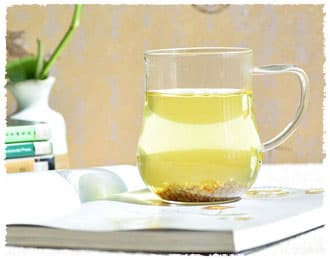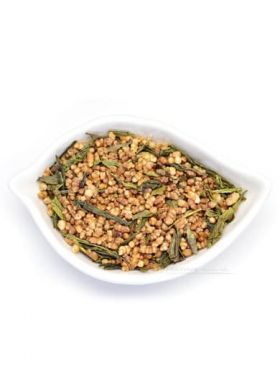-
Fast ShippingFree shipping for orders above $40
to most countries. -
Secure PaymentPay with Paypal, Credit Card …
-
Carefully SelectedFrequently Visit Tea Gardens.
Taste Repetitiously -
15 Days RefundNo Questions Asked
Refund Policy
Black Tartary Buckwheat Tea Whole Embryo
| Origin: |
Da Liangshan, Sichuan Province, China |
|---|---|
|
Harvest Date: |
Feb. 15, 2024 |
|
Dry Tea: |
Plump-eared, uniform in size, yellowish-brown |
| Aroma: |
Full-bodied wheat smell |
| Liquor: |
Yellowish green |
| Taste: |
Fragrant wheat smell, light sweet in taste, no bitterness, edible after being brewed |
| Bush: |
Liangshan Black Tartary Buckwheat |
| Tea Garden: |
XiJing Tea garden (elevation above 3000 metres) |
| Caffeine: |
Caffeine-free |
| Storage: |
Store in cool, dry place away from sunlight |
| Shelf Life: |
18 Months |
Angel's Comment:
Whole-embryo black Tartary buckwheat tea is healthy to eat and drink not only because it is pure natural but also because it has natural wheat fragrance.
Made with Black Tartary buckwheat kernels, Ku Qiao (苦荞, Black Tartary buckwheat) tea is known as a healthy, pure, ecological coarse-grain tea in many countries. There are two types of buckwheat most widely grown for tea: black and common, or yellow.
Whole-embryo black buckwheat tea is made from the whole embryo of the buckwheat, by puffing after stripping the chaff - a similar method to popcorn. The finished grain-like buckwheat seed has a yellow color, and an interesting wheat fragrance. Black buckwheat is rich in bioflavonoids, vitamins, cellulose, and protein, and it has more trace elements that other types of buckwheat lacks, so it is often praised as “the king of the five cereals”.
 |
|
Roasting method: The hulls are removed and the buckwheat is stir-fried in a stable, high heat until fully cooked.
Puffing method: This step is similar to the way popcorn is made. Under a continuous high pressure and temperature, the seeds enlarge in size (by creating irregular porous structures inside each seed), which means that the essence of the tea will be more easily released when brewed.
Germination method: The temperature is increased to 30℃ to promote the buckwheat to put forth its buds, and then its growth is terminated by forcibly ripening the buds under a low heat. By this way, the high nutritional value of the buckwheat can be retained.
Tartary buckwheat is mainly produced and distributed among the mountainous areas of southwestern China with Liangshan Autonomous Prefecture in Sichuan Province being one of the main production areas, as well as its birthplace.
The prefecture sits along the southwest of Sichuan Province in a location where geographic characteristics are varied and complicated, with topographical conditions ranging from high mountains to deep valleys, as well as smooth plains and basins, to rolling hills. The average altitude is about 3000 meters above sea level, and the highest point here, Ca Ron Dorji Mountain (恰朗多吉峰), reaches up to almost 6000 meters.
Liangshan Prefecture is located in high elevation and cold area where alpine environment provides exceptional advantages to the growth of buckwheat. There is no chemical fertilizer, pesticide in the course of growing and producing this black Tartary buckwheat tea which is natural, unpolluted and healthy.
Agopyrum tataricum, also known as tartary buckwheat, is a tropical Asian annual herb that can grow up to 30-70 cm high with seeds of about 5-6mm in length.
Buckwheat is usually found growing in mountainous areas of altitudes between 500 and 3900 meters above sea level. It loves cool, moist conditions, but is vulnerable to high temperatures and frosty weather; the optimal temperature for germination and production are above 16℃ and 26℃, respectively. Lower, freezing temperatures may cause the plants to die.
Generally, as a plant is found growing in higher elevations, it contains more nutritional substances - but produces less harvestable volume. So the particular tartary buckwheat teas grown in high-altitude, cold-climate areas are both healthier and more precious.
Tartary Buckwheat tea was awarded the title of the most unique Sichuan tourist commodity in 2006. Studies show that it has the following nutritional ingredients:
Bioflavonoid:
Bioflavonoid is commonly known as Yutin, or vitamin P, and is barely found in other cereal grains. It has a strong dying property, though, so it’s best to clean your tea cup after drinking buckwheat tea.
Mineral:
Buckwheat has become popular as a health food in many countries due to its high amounts of different kinds of antioxidants and micronutrients such as calcium, phosphorus, iron, zinc, selenium, and others.
Starch:
Buckwheat consists mainly of cabs, about 20% by weight. These carbs are in the form of starch, which presents weak alkalinity and could be aid digestion.
Vitamin:
This tea is loaded with vitamins, especially vitamin B2; the concentrations of this particular vitamin is about 2 to 10 times higher in buckwheat than it is in corn flour and rice.
Cellulose:
The fiber content in buckwheat is eight times higher than plain flour, up to 1.6% by weight. As a result, buckwheat is a good source of dietary fiber, which helps with stomach function.
Chlorophyll:
Buckwheat also contains chlorophyll, which is not very common in other cereals. It can help to purify the liver.
Protein:
Studies show that buckwheat is rich in amino acids, about 11.82% by weight.
Fat:
Tartary buckwheat is extremely high in oleic and linoleic acids, helpful to promote the growth of children as well as helping to prevent aging skin and reduce freckles.
-
5 stars17
-
4 stars6
-
3 stars0
-
2 stars0
-
1 star0










